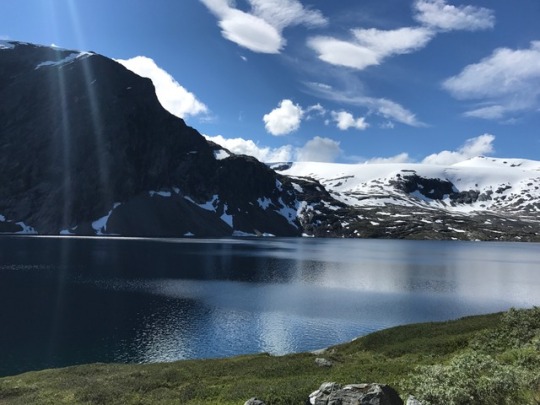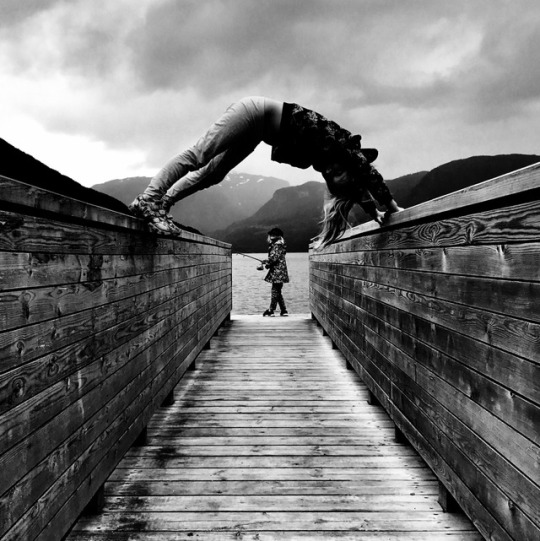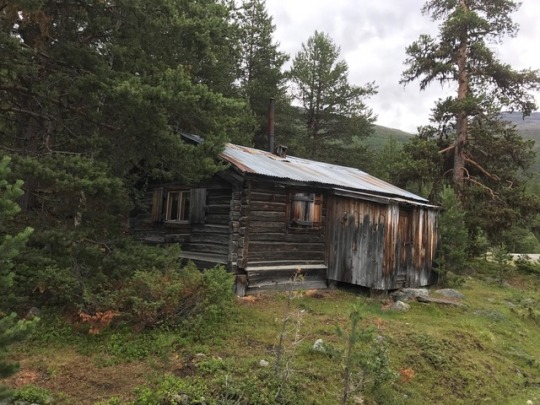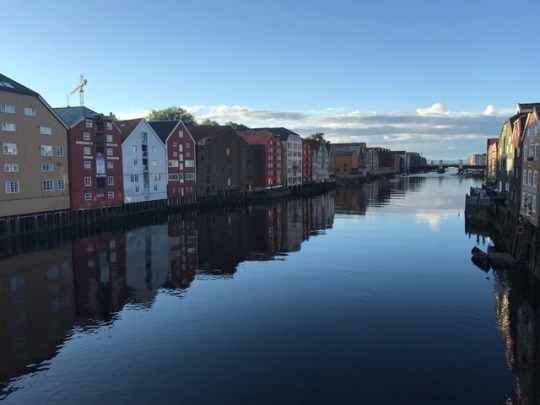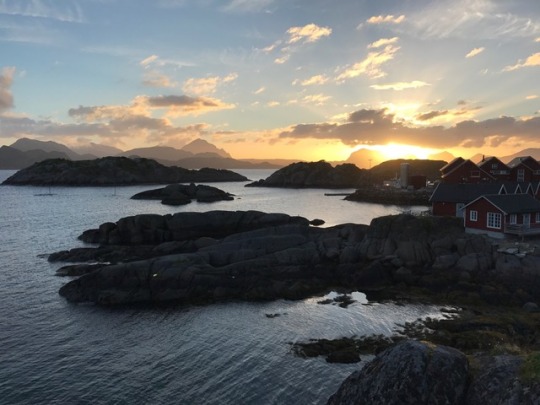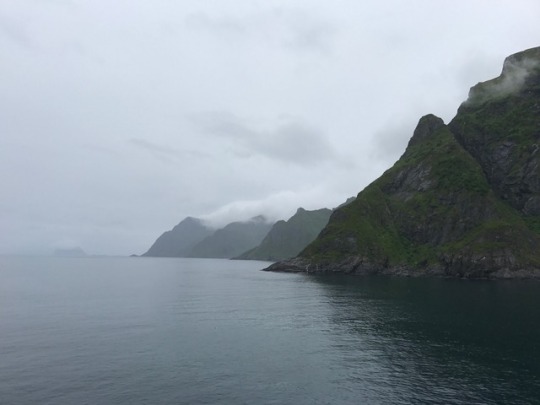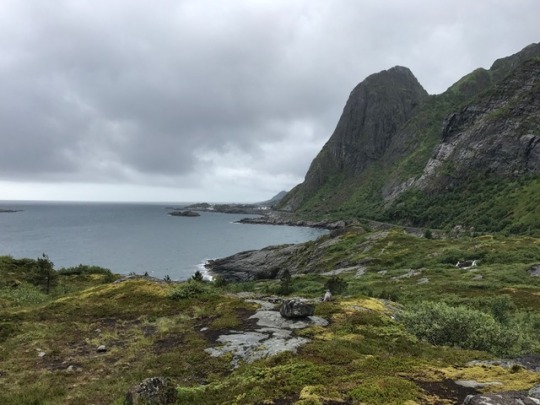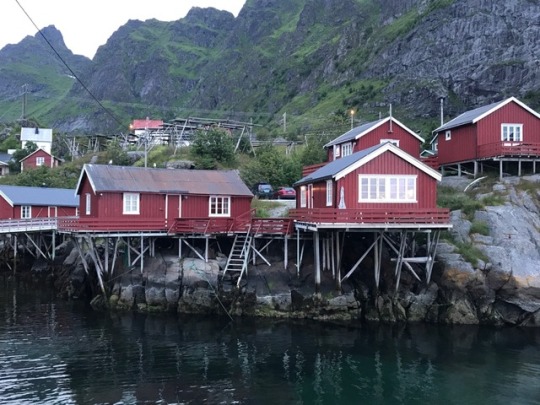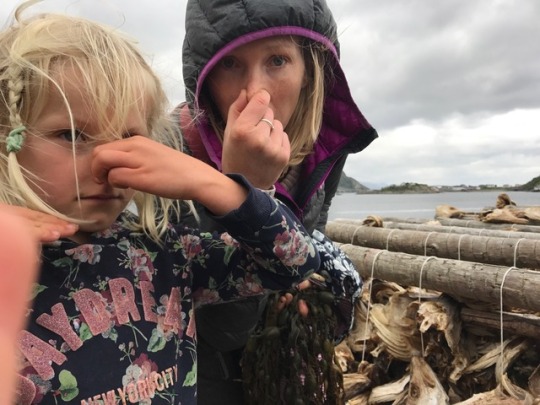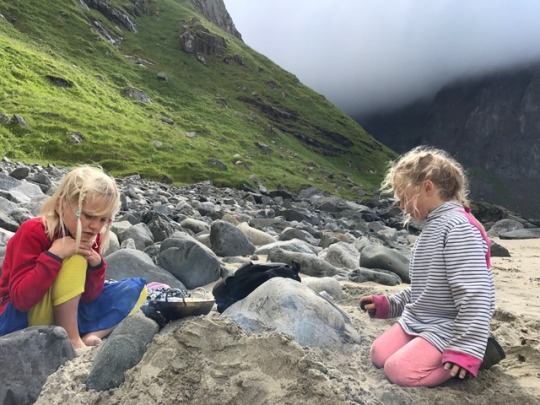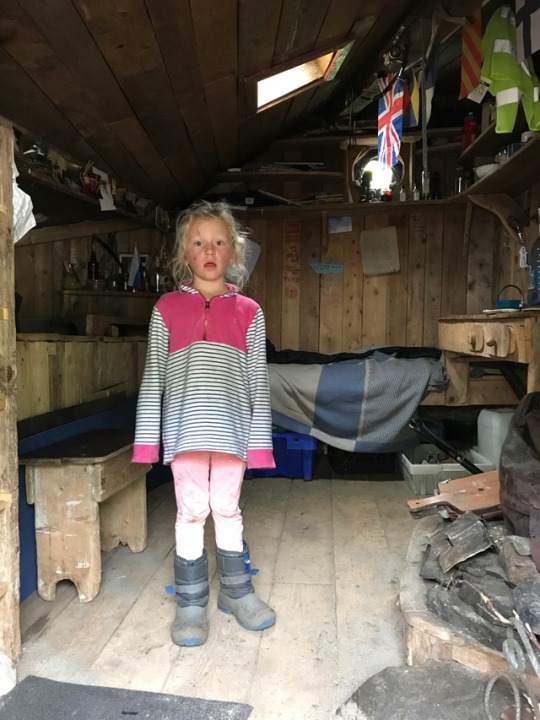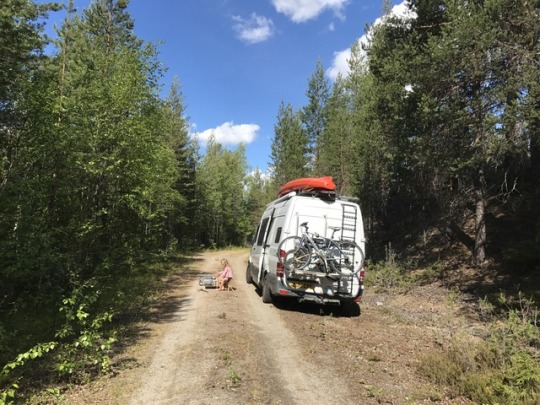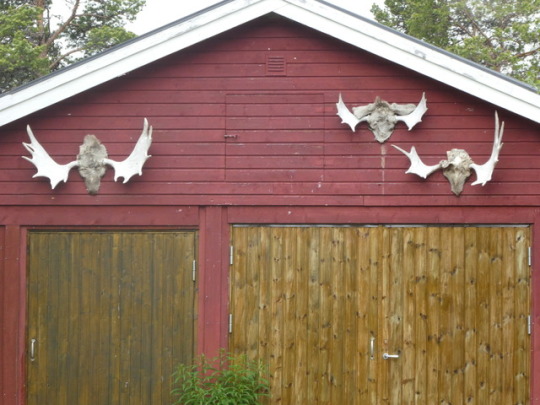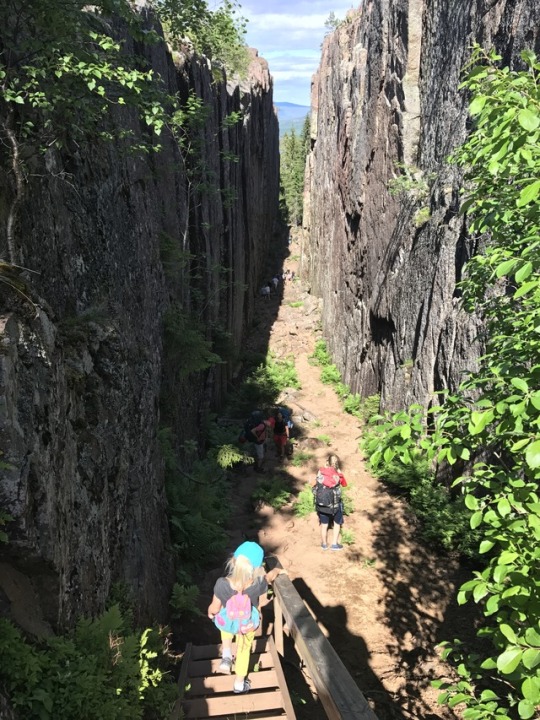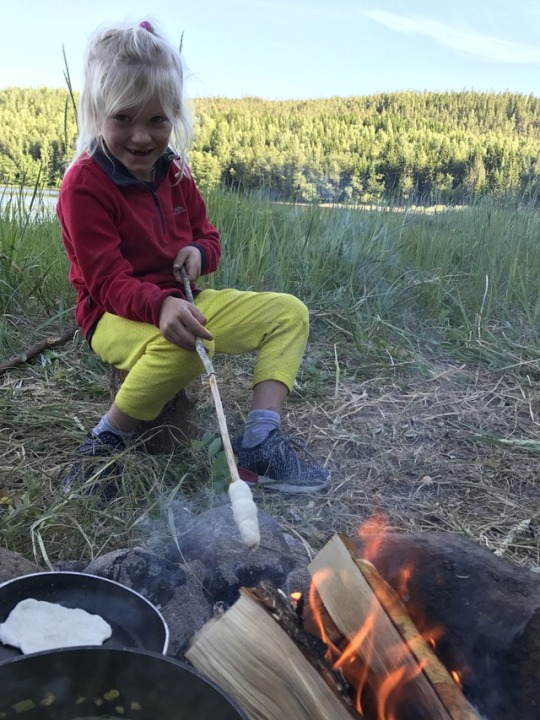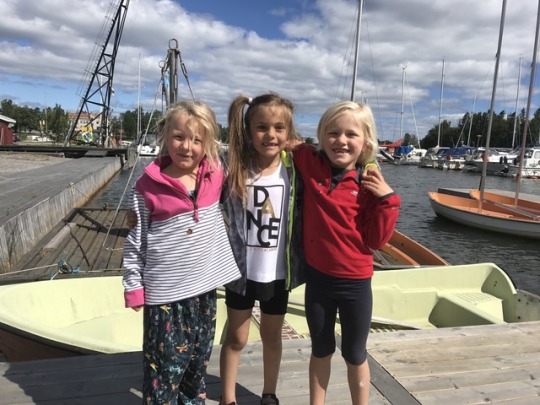Photo






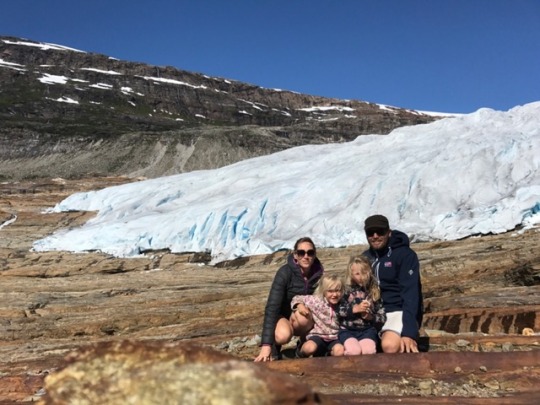

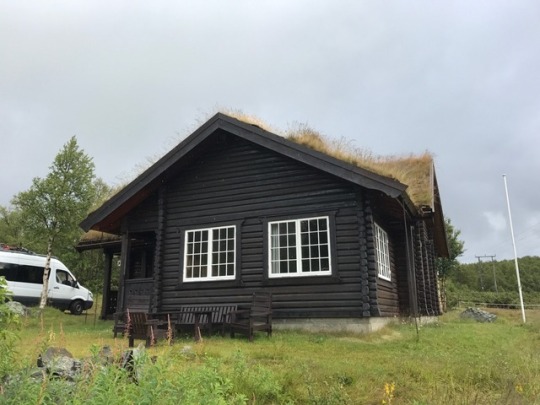
Jotunheim National Park, Troll Ladder and our stay in Thomas's log cabin
0 notes
Text
A VERY LONG WAY HOME
In the last month we have covered a gruelling 3,000km, reaching the northern extreme of our yearʼs adventure, before turning tail towards home. By August we have made our way through 25 countries, finally coming full circle. Itʼs a journey that has spanned glaciers, mountains, fjords, and volcanoes. From the desert heat of Morrocco to the midnight sun of the Artic Circle.
One thing I always wondered about this trip was what it would be like when our return date became imminent. Should we come back at all? And If we did, would we revert immediately into the same patterns? Or will the experiences prove to have changed us in some fundamental way?
Weʼve still got TWO WEEKS left (gulp!), so I canʼt be sure yet. But I think the signs indicate we are not the same as a family. For one thing Iʼve realised there is not just one way to live your life. There are many and varied possibilities. And living an itinerant existence in a camper van happens to be one of them - a perfectly sustainable one at that. Financially, thereʼs no pressing need to come home. We could afford to keep going. By renting out our house and holiday cottage in Tenby, it more than covers our expenditure. We actually spend LESS by not working. That may sound bizarre, but itʼs true. We spend less because we consume less. Marcus has become the watch guard for anti-consumerist, keeping a steely eye for any signs of weakness on our part.
Even in a country like Norway, which EVERYONE will tell you is “super expensive”, itʼs not impossible to live cheaply, if you have time and a bit of creativity. Supermarket prices are probably three times that of the UK, but in this vast wilderness there is plenty to be had for free. You donʼt need a license to fish in the fjords, and in the north especially, the fish are easy prey.
Shortly after crossing the imaginary line of the Artic Circle, we entered Norway from Northern Sweden. Immediately the landscape ramped up. Gone were the flat forests of fir scored with lakes. In their place were towering mountains with spidery waterfalls spilling straight from the heavens. Trying to outrun the rain, we pushed on to Bodø, to catch a ferry to the legendary Lofoten Islands. Weʼd heard tales of their majestic beauty, and a friendly Norwegian family we met on board the 4 hour crossing helped set the scene. At over 2m tall with long flowing flaxen locks, their eldest son looked exactly like a Viking, and regaled the girls with tales of trolls, notably, “Espen and the Ashes”. His appearance set the stage perfectly, for nowhere on earth could I imagine more Viking-worthy than that first sighting of the Lofoten Islands as they hove into view. A long string of razor sharp peaks spanning across the horizon like the scale-spiked spines of a gigantic sea monster. I have navigated the girls through Roman, Greek and now Norse mythology. And Lofoten struck me as uniquely mythical - the physical embodiment of the Midguard Serpeant, coiling itself around the Earth.
In three weeks of travelling we have seen no part of Norway which is not indescribably beautiful. Every road is a scenic smorgasbord. Every angle, every viewpoint, just breathtaking in its scale and raw, naked beauty. But even against all this, the Lofoten Islands loom large in a league of their own. They make you feel invincible somehow. A heady combination of 24 hour summer sunlight mingled with prehistoric mountains rising vertically from the sea. When the sun is shining you can hike day or night. Itʼs not unusual to spot midnight walkers, scrambling up the snaggle-toothed peaks for a view of the world spread-eagled before them. One morning I wake restless at 5.30 am, and slip out of the van to climb Reinebringen. A tough, vertical scramble, but one which rewards you with a picture-postcard view from the summit, and the sight of a sea eagle circling below.
There are harbours sheltering beneath the bulk of these impressive cliffs, flecked with grass-roofed red rorbeurs (fishermanʼs cabins standing on stilts) and giant wooden A-frames. Closer inspection revealed the purpose of these industrial-sized drying racks. For the waters around here are known for both their treachery and their abundance of cod, who come in droves to lay their eggs during the winter. The writer Jules Verne spawned the idea for his book, “Journey to the Centre of the Earth” after witnessing the maelstrom (whirlpool) off the coast of the Lofoten Isles. And long before the discovery of North Sea Oil, Norwayʼs liquid gold came from the cod liver oil harvested from these shores. We visited a quaint little fishing town called Å, where all the buildings have been turned into a museum. Peering at traditional boats, nets and glass buoys, and reeling back in horror at the stink from barrels of fermenting cod liver. One hundred years ago, black and white picture frames record a horizon packed tight with fishing boats. The flotilla then would land 70,000 cod. Now the catch is much smaller, but still large enough for every town to dry hundreds of fish on giant racks in the traditional way. At this time of year only the staring eyes and papery heads remain. Someone told us the stockfish gets shipped to Spain and Portugal as salted cod, or bacalao. The lower-value end is destined for Nigeria, as a delicacy for soups.
There are no roads crossing the sprawling islands. Instead cars skirt the edges, looping and lacing from one land mass to the next. At times this network is so narrow it becomes a series of stepping stones, made possible only by tunnels which take you below sea level. We hammered home those Norse stories by visiting a Viking museum in Vestagoy, and reach our most northerly point at Unstad, where Marcus layers up with whatever he can find to surf the Artic. He has neither wetsuit hood nor gloves, but stays in much longer than we expect, emerging only somewhat pinked to declare the water is no colder than winter back home in Pembrokeshire.
One day we hike over a mountain to the remote Kvalvika beach. Another walker tells us two friends made a documentary here, “North of the Sun”, about their experiences living for an entire winter on their own. As we straddle the pass the drop below reveals a beach encircled with cliffs shrouded in mist. The clouds act like a curtain call, hanging low, setting the scene, nature at its most dramatic. We spot a little hobbit house and long drop loo on the beach, remnants from the film; a story of human survival. For the first time we wish we could ditch the van, and go off for longer on foot. Norway and Sweden both have a policy of the individual having a “right to camp”. For this reason, itʼs normal to see a tent pitched pretty much anywhere - by a fjord, on a beach, even atop a mountain. Iʼm suddenly aware weʼre just not properly kitted out for this environment. We have “the worldʼs worst shoes” for one thing. A paltry hotchpotch of non-waterproof specimens. And no wet weather gear, aside from one pair of kids fishermanʼs trousers we picked up in a charity shop which are 2 inches too short. At €34 for a round of coffee and cakes, Norway isnʼt the country for a spending spree to get “kitted out”. Instead we brave the rainy days and scale back our ambitions. Crossing back to the mainland, and winding our way South, we stop at Svartisen glacier, bathing in the ice cold milky waters beneath. Itʼs a boat crossing plus a 2 hour walk to reach the glacier, and itʼs hard to get a sense of scale until youʼre up close. But the sight of those spearmint blue crevices get the girls declaring it was well worth it. “Like Elsaʼs Palace up close,” Elsie muses. Norway has notched up our ferry total to 19. The whole coastline is like a gigantic lung, fed by a fine weave of arteries - the fjords stretching impossibly far inland. The only way to navigate them at points is to take a ferry hop across. The main road, the E6, is said to be the longest in Europe and though the drives here are long they are never boring. It takes you past thundering rivers and sweeping fjords, over steep mountain passes where islands of snow meet lakes. Their white lips curled up distastefully by the waterʼs edge, in defiance of fate. Itʼs so utterly uncompromising in all it offers, our only difficultly proves finding somewhere off the main road to camp - suitably “off the beaten track” so to speak. There are the scenic highlights - the world-famous Geiranger Fjord, where giant cruise ships sit dwarfed alongside the multi-storey cliffs above. The fairytale wooden stave church in Lom, itʼs Viking iconograpghy from the very dawn of Northern Christianity. The “Troll Road” - a series of 11 hairpin bends taking you past architectural buildings every bit as breathtaking as the scenery. In between all this, our days are spent fishing, canoeing and cooking. Elsie and Lulu have become hooked on old episodes of Ray Mears given to us by the friend we stayed with in Bulgaria, Cen Rees. The slow-paced TV series about Bushcraft inspires us all to hone our outdoor skills. Marcus becomes a dab hand with line fishing, striking out and catching us mackerel, cod and pollock each night. Itʼs been several months since weʼve been able to cook off our stove in the van. North of Greece, the gas canisters we needed became first sparse, then disappeared altogether. Our outdoor COBB BBQ has become our salvation. One day I channel my inner Ray and idly speculate whether itʼs high time I became accustomed with this bit of kit, rather than sitting back and waiting for Marcus to sort it out. Drawing Lulu aside, I announce that “Mummy is doing supper tonight,” followed by a plaintive, “Do you want to help?” She readily agrees, and to my delight, coaches me through the entire process. “Not like that, donʼt put the charcoal on yet....errm, actually birch bark makes better tinder than paper..etc” I decide we need shelter and begin grappling with our awning for the first time in 11 months. It wonʼt unfold properly, what the hell? “I think it pulls out like this,” Lulu gaily exclaims, manipulating it effortlessly beneath me. “How do you know all this stuff?” I ask her. With no hint of guile, she replies, “I just watch Daddy.” My culinary efforts are not great. The result is a strange burnt tasting tomatoey egg soup, which is unanimously rejected and immediately earns a place in the family folklore of terrible meals. Still, itʼs a start, and, as Ray will tell you, the secret of good bushcraft is not giving up. After weʼve poached, fried, curried and smoked as much fish as we can, we put the BBQ to further use, experimenting with making waffles and donuts, supplemented with wild raspberries and strawberries. Marcus tries out advanced fire-lighting skills with mixed success. He fails to master the wood- friction bow method demonstrated with ease by Mr Mears. But his home-made WOOD GAS STOVE, using two tin cans and a fan is a roaring success. Powered purely by pine cones which the girls scramble to collect, we have the quickest cup of tea for months. In Jotunheim National Park despite having no crampons, outdoor trousers or proper walking boots, Marcus leaves us behind and attempts an ascent on the 2,500 metre high Galdhøpiggen, Norwayʼs highest mountain. He manages just, but it proves somewhat of a challenge. Five hundred metres from the summit he is walking knee-deep in snow wearing shorts and water-logged boots. People openly stop to laugh and point. One shouts, “Ah, true Viking style!” By night we befriend a lovely Belgian family with two teenage sons. Weʼre pretty smooth operators on making auspicious acquaintances now. After spying them struggling to keep their fire going with wet wood, we send Elsie out to offer them a fan and some assistance. A few hours later, the kids are eating marshmallows and weʼre sipping on Belgian beer (which tastes a lot better than the stash of Polish beer we stockpiled before coming into Scandinavia). For the next few days we become travelling companions, stopping off to fish and camp together, navigating down from Kaupanger to Gudvangen on the most intimate, up-close of Norwayʼs fjords, the UNESCO-listed Naeroyfjord. Saying goodbye to the Belgians, we make our way through the eerie boulder strewn mountain pass between Aurland and Laerdal, headed for Gol. Weʼve graduated from dropping in on long lost friends, to targeting friends of friends. Via Facebook Chris Urack puts us in touch with his Norwegian pal Thomas, who very kindly offers us the chance to stay in his mountain cabin. It turns out to be one of those romantic looking tar-stained log cabins, complete with itʼs own sauna. The type weʼd spent weeks gazing upon longingly. They sit squat in the valleys, blending in curtesy of their living, growing, grass rooves. Iʼm amazed and humbled by Thomas and his wife Monaʼs hospitality. Marcus and I joke that itʼs like WWOOFING but without having to do any work. “Weʼve morphed into CHOOFING,” I say. “Chatting on organic farms.” We left Norway behind a week ago and have spent the best part of that on the road, plummeting down through Sweden and across the bridge to Denmark, sighting the flat island of Salthomen and scores of wind farms far out to sea. Copenhagen is a welcome distraction, and for two days we stroll the canals, snack on Danish pastries and visit museums. The girls enjoy exploring “Christiannia” best - a kind of freetown autonomous commune pressed right up against prime real estate. Itʼs a bizarre enclave, of colourful DIY houses where cars are banned and we can zip about on bikes. But the sight of the notorious “Pusher Street”, where cannabis is sold openly in every strain, variety and conceivable form, casts a seedier shadow which we steer them away from. Throughout Denmark and Germany the girls endure long days driving, devising their own playlists on iTunes for us to listen to. Elsieʼs favourite trick is to try and sneak in a rogue track by U2 to really piss Marcus off. We meet a friendly German family in the Rhine Valley where we stop to cycle, sample Bratwurst, sauerkraut and schnitzel. The girls are so desperate for playmates they tend to hurl themselves at other kids, bombarding and climbing all over them. But as we enter back into the familiar territory of France I canʼt help thinking things are different to how they were a year ago. Travel has lit the touch paper on our sense of adventure. Itʼs inspired us to get properly prepared for all weather when we make it back to Wales, and strike out more often into the wilderness. Iʼve learned it is where we are happiest as a family. Iʼve also learned to listen and understand my children better. Just as an experiment, we showed Elsie and Lulu both a Bear Grylls programme on YouTube, letting them see his different approach to survival - all fast-paced fury and revolting edible experiences. Their reactions were polar opposites. We have one die-hard Ray Mears fan, and one would-be Bear Grylls. And thatʼs ok, more than anything since last September Iʼve learned to see these differences and embrace them.
2 notes
·
View notes
Video
How to save money in Norway Part 1. Save on firelighters by using birch bark
1 note
·
View note
Text
BRAVE NEW WORLD
We arrived in the land of the Midnight Sun shortly after the summer solstice. An 18 hour ferry delivered us across a heavy, toiling Baltic Sea from Gdansk in Poland to Nynnershamn near Stockholm. We’ve been here just over a week, and are still having to pinch ourselves. It’s hard not to believe you’ve been transported into a kind of Utopic vision of the future. A land where thoughtful, contemplative touches subtly reveal themselves. A society which appears to have been planned and built by people who’ve pondered deeply through the dark winter nights what would make for a pleasant living experience.
There are countries which leap out and press themselves upon your senses the moment you set foot. Morocco is one - its foreignness crowding into the pores. Not all are like that. Eastern Europe was more of an indistinct blur, punctuated only by variations in bland food and levels of indifference. But Sweden. Oh, Sweden is like waking up to the smell of fresh coffee made for you by a cool, older cousin on an outward bounds weekend. Healthy, rich, and life affirming. A wise Beowulf who’s figured out life. Taking you by the hand, and by the light of a camp fire, whispering gently into your ear that they trust and respect you enough to see for yourself if there might be a better way of doing things.
It started with the rubbish. You hardly see a general waste bin. So, we began making even more of a conscientious effort to separate all our gunk into the right recycling bins. You can’t help it - this country just makes you want to join in and be better, rather than hurling scalding hot coffee right back at its face. Then came the houses, the cycle lanes, the museums, the cities, even the wilderness. All somehow transformative.
Driving off the ferry was like stepping onto the film set of every Scandi drama I’ve ever seen. Endless spruce, and birch forests flashing past, with glimpses of the occasional deer. The classic rust coloured wooden houses hugging the coast, banks of lupins standing to attention like purple flames, tapering towards their pale ends. Stopping by a small marina, we would wander through the springy turf woodland and find ourselves brought before the waters edge, a long wooden jetty stretching ahead, the soft swish of reeds alongside. It’s hard to fathom how there is enough detective work for the likes of Wallander, Sara Lund and that Saga woman from “The Bridge”. It seems the most incongruous place to warrant such a high murder rate. It’s unlike any landscape we’ve seen so far. And the novelty adds an exotic twist. When in truth, perhaps if we stayed longer, it would soon fade. You can drive for hundreds of kilometres and the vistas, though pretty, never really change.
We spent 3 days in Stockholm. A city that flaws you with its effortless beauty and order. The vikings were not great empire builders, and the city can’t compete with the likes of Rome for sheer mind-boggling wonder. But as a place to live, it’s hard to beat. Criss-crossing its myriad bridges connecting a network of islands, we parked our van with unanticipated ease in Östermalm, smack bang in the centre. We later discovered our parking spot was the Stockholm equivalent of Belgravia in London. Yet we could stay for free at weekends, basking in the glory of the smart, stylish buildings behind us, and a bustling marina with house boats and restaurants in front. Hell even the baroque architecture seemed a testament to vitality - a wash of cinnamon, saffron, and burnt ochre, verdigris rooves mottled like lichen. We were content to just wander the city, listening out for the long sing-song vowels bubbling out around us. I tested my 4 words of Swedish on a shop keeper (Hey=hello, Ya=yes, Ney=No, and Tak=thanks). “Did I say it right?” I broke in with an immediate apology.
“Yes,” he answered with a slow sideways grin.
“But it’s not ya! You British always say it so hard.” And with an emphatic digging deep motion of his arm, he continued, “You have to really live it. It’s more like YAAAAAARRRR….”
We stumbled into a street performance festival taking place, and even here the city embraced it’s ambition to go 100% cash-free. Instead of putting money into a hat, the audience was encouraged to “Swish” a monetary donation via their phones. The crowd is noticeably more ethnically diverse than any we’ve seen for months. One little boy is picked to be a volunteer. When the performers ask where he is from, he tells them Syria, and the crowd cheers in applause. The girls insist we must sit up front and sure enough Marcus is also selected - twice - to be part of some human scaffolding. Must be his strong, muscly physique I guess! The girls find it hilarious to watch their dad being dressed up and climbed all over by ladies wearing big frilly knickers.
The city is easy to negotiate on foot and by bike. At first the cycle paths strike me as alien, futuristic somehow. And then I realise it is because I’ve never seen routes so well integrated into a city before. There is an odd epiphany, a gradual dawning which is to repeat itself. The realisation that we’ve found a place that’s not just different from home. It’s better. A Brave New World. One island, Djurgården, houses most of Stockholm’s museums. It’s crowning glory is the Vasa, a wry reminder that Swedish design wasn’t always so flawless. In the 17th century the Vasa warship sunk on her maiden voyage, just 1 kilometre out of the harbour. As an 11 year-old I remember a school trip to Portsmouth to see conservation work on the Tudor equivalent, the Mary Rose. The Vasa would have made Henry VIII apoplectic with envy. Towering five storey’s high, the museum is constructed around her many levels - the tops of her masts even poking out through the building’s roof. Journeying through the different parts of her structure you are treated to a smorgasbord of historical insight. The presentation and forensic detail is astounding. It’s like a brainstorming session that actually got gloriously realised, rather than chewed up, compromised and ultimately bodged. There were brightly coloured copies of a select few of the 700 adorning wooden sculptures, intricate models, replica parts of the ship for you to enter, visual displays and films showing how the ship was built. But best of all, were the reconstructed faces of the skeletons found on board. So life-like you could even see the sweat glistening on their skin. Elsie and Lulu were transfixed, asking again and again about one young woman in particular. Analysis of her teeth showed not only that she had been malnourished as a child, but that she was probably a seamstress. The tell-tale clue was a groove in her right incisor tooth, consistent with having bitten off thread over and over again. God I just love that! And so did they, you could practically hear their brain cells popping as the puzzle slid into place like a true Scandi-detective!
The only things not so appealing about Sweden are the cost, and the noticeable dip in air temperature. In Croatia we were baking beside azure mediterranean waters, feeling like we were on summer holiday. We spent a week in the fishing village of Pučišća on the island of Brac, which I’d visited with girlfriends a few years before. Despite numerous fans Marcus had rigged up, the heat of the van became unbearable. Sticky, sweaty seats, and nights where everyone bar me was eaten alive by mosquitos. I am the envy of my entire family, the only one seemingly immune to the blood suckers. We bought inflatables and sought shade in an apartment for a few days, gorging on nectarines and flip-flopping in and out of the water. It was a chance to bide our time and energy before taking the girl’s to see their first ever experience of live rock in the capital Zagreb. The “InMusic Festival” website said it was kid-friendly, but I think they must have been counting the swarms of fresh-faced teenagers in that description. We spotted about 5 other small kids, but in the end rarity worked to our advantage. Elsie and Lulu attracted plenty of attention in their bright yellow ear defenders. Sweet-natured 19 year-old girls would stop, and gasp. Allowing sticky little paws to stroke their fairy wings as they crouched low to boogie along, before leaving a swipe of face glitter as a departing gift. Elsie couldn’t quite believe that grown-ups got to dress like that. All her fairy/princess/frozen ambitions seemingly crystallised to perfection. They stayed up till midnight to watch ‘Arcade Fire’, whose music Marcus had been steadily indoctrinating into them weeks before. The band were amazing, but I know they’d have sounded even better if I didn’t have one person digging into my shoulders and another trying to yell an inane, frankly not very interesting question, into my ear. Though fun, I couldn’t escape the feeling that Croatia felt like one giant tourist attraction. We never quite got a sense of the people or the place. It glittered, but left us cold, despite the 30-degree heat.
Our summer spending spree continued north into Hungary. Moving so quickly now, there was barely time to learn the currencies and please/thank you before passing from one border to the next. Across the flat European plain we travelled, through villages whose modest one-storey houses would draw the eye. Not the buildings themselves, but to what lay beyond - chickens and dust and glimpses of an older, subsistence life. The traditional style barns, set back, giving on to wide open fields of corn. There was the odd nodding donkey in the flat terrain too - an oil gathering relic seemingly from another age. We spent so little time in Hungary, Austria, Slovakia and Poland we were gripped by a kind of frenzy. Eating out all the time - trying to cram in goulash, strudel and dumplings. Casting around for places to stop, we lost our way, and were falling back into old habits, hitting the big tourist sites which leave you feeling as hollow as your wallet. It was a kind of desperation I think, an attempt to distract ourselves from the creeping awareness that we had almost gone full cycle. The olives and almonds we had first picked in Spain were now ripening again on the trees. Fields of sunflowers which had been slumped before the French sun last September, were now rising up in worship once more. Thoughts of home preyed on our minds. How were we going to get used to going back to a sedentary life filled with routine? Freedom is addictive, and however much we miss friends and family, we’re not relishing that sacrifice.
In Slovakia we visited beautiful Bratislava, and then stopped for a couple of nights in the Tatras mountains. I’d read rave reviews about the compact Carpathian mountain range, but either we were missing a trick, or it just wasn’t that great. Compared to the wilderness of the Accursed Mountains in Albania, it felt tame and commercialised. In the ski-town of Strebske Pleso we took a chair lift and then hiked up to Solsiko at just over 2,200 m. A revised version of Spartacus spurred Elsie and Lulu up the steep, rocky summit, where we passed scores of other neon-clad Slovakian day trippers. It was the mountaineering equivalent of painting by numbers. You go through the motions, but the end result is uninspiring. Poland was even less so, perhaps because here it actually felt like we HAD arrived back in Britain. Tesco stores sprouting up alongside motorways under cold, grey skies.The familiar miserliness of toilet stops where you are charged to use the loo. The mediterranean, with its soft warmth, never felt so far away.
We stopped at Poland’s premier tourist attraction, the Weilizcka Salt Mine. A vertical shaft with a staircase that plunges you 110m underground, where tunnels open onto caverns shiny and solid with rock salt. We couldn’t resist licking the walls to test if they really are salty. They are. It’s actually pretty interesting, huge chambers, even an underground cathedral carved from salt. Our guide’s sense of humour is as dry as the atmosphere inside the mine, but it can’t disguise the fact it’s still one big tourist rip off. Afterwards we make a vow: no more big tourist attractions where you’re herded and cosseted. Stripped of your dignity along with your cash.
Krakow was a delightful exception, with its curiosity shops and old world charm. I’m not one to water down history lessons for the girls, and I rarely shy away from telling them the truth - in all its grizzly detail. But the haunting sight of those dilapidated buildings in the old Jewish Quarter proved too much even for me. We skirted awkwardly around the subject of Poland’s tragic past. The enormity of the Holocaust is not a story I can bear to tell them just yet.
Long days of driving followed, sometimes 600 km a day, to get to the port at Gdansk. The girls coped well, entertaining themselves by DJ’ing from their seats in the back. Elsie loves the song “Pusher Man” by Curtis Mayfield. We can’t help grinning as she delightfully misinterprets the lyrics.
“I can’t believe he’s saying “Want some coke, have some wee!” she crows. “Who would want wee?”
The coast west of Gdansk is an unwelcome sight. It puts me in the mind of Barry Island. Thronging with the bucket and spade brigade, and lined with fish and chip joints. For the first we are officially further north than when we left Wales 10 months ago. Roughly on a par with the Lake District. It was tempting just to hot foot it back to Southern climes. But I’m glad we pushed further North now into Scandinavia.
The wilderness begins right outside Stockholm. Hugging the coast northwards, we’ve seen the sunset shift ever onwards until finally it now just hovers above the horizon. I didn’t think their bedtime could get any later, but it’s gone beyond now. By blacking out the van we try and sleep. But it still amazes me to see the world softly lit, as if by gas light, every time I wake in the middle of the night and step outside to wee. We’re making friends along the way. One evening we got chatting to a father and his daughter, Elsa, who taught us the card game “Go Fish” in Swedish. But Elsie and Lulu’s favourite word is undeniably “exit”. Which is the superbly satisfying “utfart”.
Wrapping our tastebuds around salted liquorice, crackers, and cinnamon buns, we are driving north, trying to muster up the courage to sample possibly the world’s most challenging food: Surstromming, an explosive Swedish delicacy of fermented herring. There’s a stop along the way, at the Skuleskogen National Park. A magical landscape, where it’s easy to believe trolls and fairies dwell. Finally we get to see the wood for the trees, for this is the High Coast, where you can climb above the forest and gaze down upon islands mushrooming out of the Baltic Sea below. The land here has been rising by 8mm every year since the last ice age 10,000 years ago. Geological signs of this shift are all around. We take a 8km hike past prehistoric beaches and bronze age burial mounds through enchanted woodland, brimming with bearded lichen. At least here we never have to worry about setting off by a certain time. It doesn’t much matter how long you take, with 24 hour sunlight there’s never the need for a torch to find your way home. Our walk brings us out into a sheltered bay with a camping spot at Kälsviken beach. There are composting toilets and shelters with seasoned wood, the odd fire roasting pit, even neat piles of logs stacked around the beach. We watch a teenage boy splitting logs, and I assume he must have brought his own equipment. But he finishes up, hammering the axe into a chopping block, and gesturing for us to go ahead. It slowly dawns on us that all these thoughtfully placed touches are for general use. “God, it just seems so advanced here!” Marcus exclaims.
In the last few days we’ve delved even deeper into the wilderness, and are now sleeping so little I am beginning to wonder if we shall soon go full circle and gain an extra day. Crossing into Lapland we tracked down another long lost friend of Marcus’s, Lisa Angberg. He’s well supplied with mates out in the sticks! Lisa, Pablo and their 6 year old son Theo run a tourism business, Stora Björnstugan, up in Laisvallby in northern Sweden, renting out wooden cabins. They have welcomed us with such warmth and wonder I hardly know where to begin. We’ve eaten Reindeer, Elk, fished for Coregon on the river, had a sauna, and learned from Lisa all about the many uses spruce pine and birch can be put to. There I was thinking all this woodland was purely for flatpack furniture, but she’s shown us another world of forest shampoos, conditioners, syrups, sap you can drink. I wish we could stay, the endless light adds a kind of mania. It’s become normal for the kids to stay up till midnight, going out in the boat, or playing amongst the wildflowers in the garden. It’s wonderful, magical. We love you Sweden. You’re everything I dreamed and more. And we haven’t even seen you dressed in your winter finest yet. We will be back.
2 notes
·
View notes











